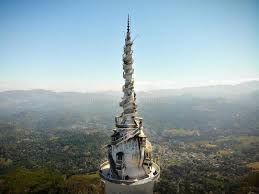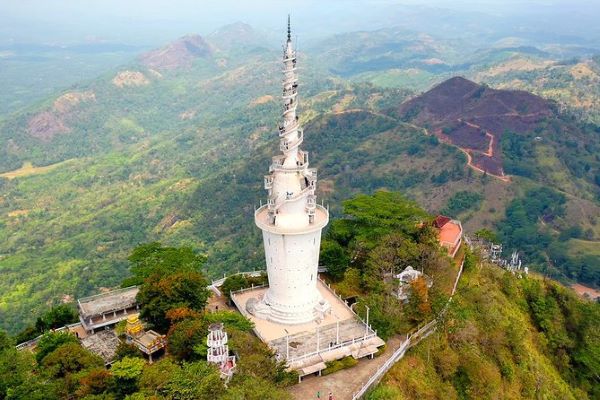Ambuluwawa Biodiversity Complex – unique blend of nature and human creation
By Arundathie Abeysinghe
 Engulfed in mist during early mornings and late evenings, a picture of surrealism, a precipitous drop and breathtaking vistas, Ambuluwawa Biodiversity Complex is an icon looming in the distance when viewed from *Gampola town… At the summit of the stupa, the landscape unfolds below until the white cloak of the veiled mist creeps surreptitiously engulfing the surroundings into oblivion similar to a picture postcard…
Engulfed in mist during early mornings and late evenings, a picture of surrealism, a precipitous drop and breathtaking vistas, Ambuluwawa Biodiversity Complex is an icon looming in the distance when viewed from *Gampola town… At the summit of the stupa, the landscape unfolds below until the white cloak of the veiled mist creeps surreptitiously engulfing the surroundings into oblivion similar to a picture postcard…
Ambuluwawa Peak is situated in the center of former Gampola Kingdom approximately 25 kilometers from Kandy City on an area of 327 acres (approximately 132 hectares). It is a landmark of Gampola, former kingdom of King Bhuwanekabahu IV (1341-1357 AD) who ruled Gampola Kingdom. Gampola is entrenched in history and endowed with nature and biodiversity as well as a mild climate. Ambuluwawa Biodiversity Complex, the first multi-religious complex in Sri Lanka is a blend of nature and human creation and can be seen from many places in Gampola town.
The standing Buddha Statue, the 48-meter stupa (dagoba) with a spiral stairway extending up and along the exterior of the stupa with doorways opening out to small viewing decks (with a viewing deck on each level) with great depths of vistas that can be viewed along its ascent and the stairs emerging outward at the end of the climb are the greatest attractions of the Biodiversity Complex. At the peak, Gampola town can be seen in miniature form. The design of the stupa is a derivation of the traditional Sri Lankan wee bissa (granary).
 There are also many places of interest in the biodiversity complex such as Kuttam Pokuna (twin ponds) similar to those in Anuradhapura*. There is also a seated Buddha statue about ten feet (approximately three meters) tall which can be seen from far as well as a brass icon of the Buddha with a row of wooden shrines for deities hoisted on posts and a pirith mandapaya (structure for chanting *pirith) endow the serene landscape, forming a spiritual medley.. The signboard at the entrance to the Biodiversity Complex and Religions Centre has symbols of all four religions, a spiritual diversity, the only place in Sri Lanka where there are symbols of all four religions in one place.
There are also many places of interest in the biodiversity complex such as Kuttam Pokuna (twin ponds) similar to those in Anuradhapura*. There is also a seated Buddha statue about ten feet (approximately three meters) tall which can be seen from far as well as a brass icon of the Buddha with a row of wooden shrines for deities hoisted on posts and a pirith mandapaya (structure for chanting *pirith) endow the serene landscape, forming a spiritual medley.. The signboard at the entrance to the Biodiversity Complex and Religions Centre has symbols of all four religions, a spiritual diversity, the only place in Sri Lanka where there are symbols of all four religions in one place.
According to inscriptions in the Biodiversity Complex, the Buddha Statue in the premises was unveiled in 2007 and the Biodiversity Complex was opened in 2009.
Mayura Sandeshaya (meaning ‘The Message of the Peacock’ written 14th century AD) describes the spectacular Ambuluwawa Peak as follows:
“When the planets and stars disappear from the sky and when the nectar appears in or drops from flowers on tree tops and when the sun spreads its rays as it rises over the mountain of the east, you may set off from Ambulwakada happily’ (Mayura Sandeshaya, verse 25).
Ambuluwawa is popular among tourists as there is a unique spectacular structure which resembles a spiraling cone that houses Sri Lanka’s first multi-religious center as well as the Biodiversity Complex.
There is a Bo tree at the Biodiversity Complex, grown from the appendage of the Sacred Sri Maha Bodhi at Anuradhapura.
Among the other attractions of the Complex, there are walking trails, herbal gardens, twin-ponds, water parks and stone gardens, unique features.
There are also experimental plantations and gardens in the Biodiversity Complex, a fine example of a new boom in of agro economics. The International Conference Hall on Agronomy is equipped with state of the art equipment to conduct conferences.
The area above the artificial lakes in the forest is inhabited with deer (Axis axis ceylonensis) and sambar (Rusa unicolor unicolor) as well as several endemic birds and mammals.
The roads at the Biodiversity Complex with cliffs and sharp drops leave an unforgettable memory for travelers.
Apart from historical and cultural sites, Ambulawawa has an international-level conference hall, as well as a Center for Agrarian Research. As such, many experiments with regard to the diversity of vegetation are carried out at the Complex.
Ambuluwawa is a unique rock mountain in Sri Lanka as it is made up of a special type of rock known as “Inselberg” which is least subject to erosion caused by natural environmental causes. The soil at Ambuluwawa is reddish brown and belongs to latezoic type. There are about 200 varieties of plants which belong to 80 plant families at the Biodiversity Complex.
The Biodiversity Complex offers breathtaking vistas of *Sri Pada, *Pidurutalagala, *Namunukala, *Batalegala, *Alagalla, *Hantana as well as several other spectacular mountains.
As the panoramic views from the Biodiversity Complex are breathtaking visitors spend several hours in the location basking in the glory of the vistas.
Although, there are modern developments at the Biodiversity Complex, visitors pay special attention to preserve its natural resources.
Local and foreign scientists conduct continuous research in the Biodiversity Complex reserve.
Location: Nidahas Mawatha, Gampola, approximately 25 kilometers from Kandy City
Directions: From Gampola town, travel along Nidahas Mawatha, accessed by the Station Road with a gradual ascent with views of Gampola town and *Mahaweli River in the distance.

- Alagalla – Alagalla Mountain Range also known as “Potato Mountain Range” and known as “Tuber Rock” in English is situated at an elevation of 1,140 meters. The Mountain Range is situated at the border of the Central and *Sabaragamuwa Provinces. The highest point of the Mountain Range is Bible Rock.
- Anuradhapura – A major city in Sri Lanka (former Ceylon), the capital of Anuradhapura District. Anuradhapura was one of the ancient capitals of Sri Lanka and is famous for its well-preserved ruins of Sri Lankan civilization. Founded in the 4th century, Anuradhapura was the capital of Sri Lanka until the beginning of the 11th Anuradhapura is considered sacred to Buddhists and there are monasteries, stupas within an area of 40 square kilometers, Situated 205 kilometers north of Colombo, Anuradhapura was declared as the “Sacred City of Anuradhapura” and a World Heritage Site by UNESCO in 1982.
- Batalegala – A mountain near Aranayake in Kegalle District in central Sri Lanka. It was known as “Bible Rock” during the British Colonial Era as its surface resembles a book/bible. Due to its prominent flat top surface, it resembles the more famous Sigiriya citadel located more north of it.
- Central Province – Located in the central hills of Sri Lanka, the Province has three administrative districts; Kandy, Matale and Nuwara Eliya.
- Galaha – A mountainous area with green hills and natural water sources located within the Central Province of Sri Lanka.
- Gampola – A town situated in close proximity to Kandy in the Central Province of Sri Lanka. Gampola was established as the capital of Ceylon by King Buwanekabahu IV (from 1344 – 1345 and from 1353 – 1354) in the mid 14th
- Hantana Mountain Range – Situated approximately 1240 meters above sea level, Hantana Mountain Rangeis in central Sri Lanka, south-west of Kandy City. Hantana Mountain Range stretches from Kandy City to the town of *Galaha situated about 20 kilometers to the south of Kandy City. University of Peradeniya is situated in the foothills of Hantana Mountain Range. There are seven peaks in the mountain range.
- Namunukala – Literally meaning “Nine Peaks” in Sinhala Language, Namunukala is a mountain range in *Uva Province of Sri Lanka.
- Pidurutalagala – Popular as Mount Pedro among foreigners, Pidurutalagala (meaning Straw Plateau Rock in Sinhala), is the highest mountain in Sri Lanka situated at an altitude of 2,524 meters. Situated towards North-East from Nuwara Eliya town, the summit of the Mountain is the location of the central communications array and radar system of the Government of Sri Lanka. The summit of Pidurutalagala Mountain is designated as an “Ultra-high security zone” by the Government of Sri Lanka and the summit is protected by Sri Lanka Army. Hence, general public cannot access the summit of the Mountain.
- Pirith – Paritta (in Pali) refers to the Buddhist practice of reciting verses and scriptures as recommended by the Buddha to protect from certain afflictions. There is a belief among Buddhists that all-night pirith recitations by Buddhist monks provide safety, protection and well-being to a community.
- Sri Pada – Located in Central Highlands of Sri Lanka, Sri Pada also known as Adam’s Peak has been a pilgrimage site for more than 1000 years. According to Buddhists, the footprint at the summit of the peak is the Sacred Footprint of the Buddha. Adam’s Peak is one of the tallest peaks of Sri Lanka (2243 meters height). It is a mountain climbed for religious purposes (due to its significance for all four religions in Sri Lanka) as well as for its breathtaking views made up of densely covered jungle as well as cliff drops. This Peak is popular among pilgrims as well as local and foreign tourists. The season to climb the peak is from December to May.
- Uva Province – The fourth largest province in Sri Lanka bordered by *Central, Eastern and Southern provinces.
Image courtesy: lifestylesrilanka.com & activities.marriot.com







